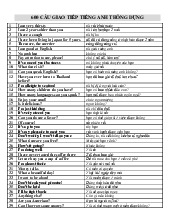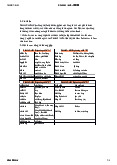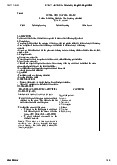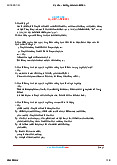











Preview text:
20:53 29/7/24
Lesson Plan For Speaking Part 2
Lesson plan – B2 First for Schools Speaking Part 2 Description
This lesson plan is designed to help students prepare for B2 First for Schools Speaking Part 2 – the long
turn. It can be delivered face to face or online. The ‘online options’ column gives teachers ideas about
how the stages could be adapted for teaching online. Time required: 60 to 90 minutes Materials
Copies of the Student handouts for each learner. Consider emailing a copy required:
of the handouts to each learner in advance if you’re teaching online (excluding the Answer key). Board and markers
Presentation slides if teaching online Aims:
Boost students’ range of vocabulary related to free time and entertainment
Review useful expressions for speculating
Practise exam strategies for Part 2 such as speaking for a minute,
continuing to speak when students don’t know a word, using useful expressions
Reflect on strengths and areas to work on for Speaking Part 2 Procedure Lesson stages Online options Warm-up
Padlet or similar online tools work well for brainstorming
Draw a table on the board like the one below with one or two examples of indoor activities.
and outdoor entertainment added: If you have the option and it is safe to do so, put each watching TV
playing or watching an outdoor group into a breakout room to brainstorm their ideas
sport visiting a museum or art gallery
going to an amusement park onto your Padlet wall.
Put students into small groups and tell them they are going to play a game called Wipe Out.
How to play: Groups nominate a writer then work together to list as many
activities under each heading as they can think of. The aim of the game is to think
of activities that no other group has – these are the only ones they get points for!
Set a time limit of one to two minutes.
When the time is up, go around the class, group by group. A spokesperson from
each group reads out their activities. Each time a spokesperson reads out an
activity that other groups have also written, everyone crosses it out.
At the end, groups count up their points for the activities that no one else had, and
give a round of applause to the winning team.
Copyright © UCLES 2021. All details are correct at the time of publication in June 2021 1 about:blank 1/12 20:53 29/7/24
Lesson Plan For Speaking Part 2 Focus on vocabulary Share Task 1 on your screen Students note
Student handout Task 1 Focus on vocabulary: Ask students to look at the answers in their notebooks
pictures and match them to the vocabulary in the box. before checking together as
If some of the activities are unfamiliar to your learners, ask extra questions or a class.
show another picture to check that they understand. Asking students to type For example: answers in the chat helps
Show pictures of or social media memes about popular activities. avoid putting them on the
Ask for examples of things you can do at an amusement park. spot and reinforces the spelling of new words.
Model and drill the pronunciation of any words that your learners might find difficult.
Highlight features of form that are relevant to your learners. For example, they
could underline the verbs, notice collocations such as take part in or use of the
preposition to after go. Building fluency If you have the option and it is safe to do so, use
Student handout Task 2 Building fluency: Put students into pairs to ask and breakout rooms for the pair
answer the questions. Encourage them to use the phrases from the useful discussion.
language box to help them construct more varied sentences. Monitoring
As you monitor, take opportunities to add more useful vocabulary as learners
need it – perhaps the names of different rides at the amusement park or things It’s easy to switch between
you might find at a food festival such as food stalls. breakout rooms if you have them. Turn off your video
Round off this activity with some feedback on examples of good vocabulary or and audio to monitor more common errors that you heard. discreetly. Chat can be monitored in real time. If your technology does not have this function, ask learners to post their answers in the chat box. Pick up on one or two interesting answers during feedback and ask learners to expand on them. Exam strategies This could be done as a class. Use elicitation
Information about Speaking Part 2 and Top tips questions with short, simple
If your learners have seen a Speaking paper before, ask them to briefly discuss in answers to encourage
pairs what they remember about Speaking part 2. Ask them if they have any learners to contribute e.g.
advice for this part of the test. Do you talk for 2 minutes or 3?
Feedback: Check in with the class – do they have any ideas they want to share?
Now students can compare their ideas with the Exam strategies -Speaking Part
2 and Top tips box in the Student handout. about:blank 2/12 20:53 29/7/24
Lesson Plan For Speaking Part 2
Exam strategies Analyse If you have the option and it is safe to do so, use a model answer breakout rooms for the pair
Draw students’ attention to the sample exam question, the example answers and discussion. the Student handout T
ask 3 Analyse a model answer .
Students read the sample answer and answer the questions in Task 3 individually
and then compare their answers in pairs. See answer key for feedback. Useful language If you have the option and it is safe to do so, use
Useful language for speculating breakout rooms for the pair
Ask students to read Task 4 Useful language then look back at the text to read discussion.
the expressions in bold and circle the best response.
Point out that these phrases can be used to speculate even when you are not Students can share example
really sure what the people are thinking, feeling or doing in the picture. sentences in the chat or on
Student handout Task 5 Speculate about a picture: Ask students to choose a a Padlet wall.
picture from Task 1 and complete the sentences. Monitor and correct/note down
common errors for delayed feedback.
Students compare their answers.
Feedback: Write some good examples on the board and some examples with
common errors for the class to correct. Exam practise Part 2 If you have the option and it is safe to do so, use
Student handout Task 6 Exam practice 6: Put students into groups of 3 – breakout rooms for the pair
Student A is the Examiner and the other two students, Students B and C are the discussion.
candidates. Give them a minute to read the instructions on the Student handout
and decide on their roles. Ask the Examiners to put their hands up and nominate Alternatively, consider
someone to explain their role to check understanding. getting learners to record their answers offline – they
Monitor as the learners complete the task, noting down any good examples you can submit them using an hear or common errors.
application like Padlet or
Note: In the exam, learners may be tested in groups of two or three. If it is a Flipgrid.
group of three you will need to add extra time for the third student. Reflect and improve If you have the option and it is safe to do so, use Student handout T
ask 7 Reflect and improve :
Before you give your feedback, breakout rooms for the pair
give the students a chance to reflect on how successful they were and how group discussion.
discussions could help them improve.
Feedback: Nominate a student from each group to share their ideas. There are
also some suggested ideas in the Answer Key. Share any you think your students might find useful.
To round off, praise the students for the good examples of vocabulary or well-
constructed sentences you heard after Task 6 – write or display them on the
board to help students learn from each other. about:blank 3/12 20:53 29/7/24
Lesson Plan For Speaking Part 2
Write up any common errors and put learners into pairs to decide how to correct them. Check answers together. Idea for extra practice
This could be used as an extension to the lesson or for homework. If students This works well online too!
want to practise speaking from home they can record themselves speaking about
the pictures, and then listen back and assess their speaking performance against the checklist.
To practice talking about pictures, create an Image Picker Wheel by uploading
pictures of your choice for your learners to talk about.
Spin the wheel to randomly select an image and challenge learners to talk for a minute describing: What the people are doing Where they are How they might be feeling.
After the first picture, you can ask students to compare the new picture with the previous one. Useful links Learning English Teaching English The Mock test toolkit
Lots of resources to help your
Find the teaching resources you
Includes links to sample papers, learners keep practising! need such as lesson plans and
information booklets and preparation activities. materials. Quiz your English App Speaking test videos Webinars
Motivate your learners to review Show your learners a real
Learn more about preparing learners for the grammar and vocabulary Speaking test so there are no
the Speaking test in our webinars for
they need for the test with our surprises on exam day. teachers. latest App. about:blank 4/12 20:53 29/7/24
Lesson Plan For Speaking Part 2 Student handouts
Task 1 Focus on vocabulary
Match the different activities to the pictures. go to a food festival
practise skateboarding tricks. take part in a musical or theatre group go to an amusement park
have dinner with family and friends share funny videos and a b c d e f i about:blank 5/12 20:53 29/7/24
Lesson Plan For Speaking Part 2 Task 2 Building fluency
Ask and answer the questions in pairs. Use the useful phrases to help you. Questions Useful phrases
a. How often do you do the activities in Task 1? I never/rarely ... I ... now and again. I … once / twice / a few times. I used to ... but not anymore.
b. Would you like to try any of the activities you
I’d quite like to try [going to an amusement
haven’t tried yet? Why? Why not? park] because …
I really wouldn’t like to try [practising
skateboarding tricks] because …
c. What do you think people enjoy about these
I think people probably enjoy [going on different activities?
different rides] because ...
d. How do you think people feel when they do People might feel… these activities?
Some people could be … Exam strategies Speaking Part 2 Top tips In this part of the exam:
The topic you need to talk about is written on the paper above
the pictures. Read it carefully. The examiner will show you two photographs and ask you
Use a range of grammar and vocabulary. For example, avoid
to talk about them for a minute.
simple adjectives like nice and good. Then the examiner will show
Pay attention to your partner’s pictures and what they say about your partner two different
them, so you are ready to answer the final question.
photographs. After your partner has spoken for a minute the
At home, practise talking for a minute on different topics. Use a examiner will ask you a
timer so you get an idea of what one minute feels like.
question about your partner’s photographs.
Record yourself speaking for one minute. Listen back and think
about what you did well and what you need to work on. about:blank 6/12 20:53 29/7/24
Lesson Plan For Speaking Part 2
Task 3 Analyse a model answer Sample question ii
What do you think the people are enjoying about these activities?
Look at the sample question and the pictures. Read the model answers and answer these questions:
a. List the things Ada mentions that make these activities enjoyable: Outdoors/sunny day
b. What word does Ada forget? What strategy does she use to keep talking?
c. Why does Rosie use the word ‘too’ at the end of her answer? about:blank 7/12 20:53 29/7/24
Lesson Plan For Speaking Part 2 Model answer Candidate 1
Well, in the first picture the people are enjoying the outdoors on a lovely sunny day.
They are having fun on a…I’ve forgotten the word for it…the amusement park ride –
it goes up and down. Some of the people appear to be on a day out with their family
or friends. Some of them might possibly be a bit nervous but they are waving their iii
hands in the air, so I think they probably enjoy going on scary amusement park Ada
rides. In contrast, the people in the second picture are at home. They look like they
are watching a really exciting film or drama on TV. They are enjoying watching it as
a family. They seem excited or surprised by the show. Examiner:
[to Candidate 2] Which activity would you enjoy the most? Candidate 2
I think I would prefer watching a film with my family. I’m scared of heights so I’d be
nervous about going on a roller coaster too. iv Rosie Task 4 Useful language
Look at the expressions in bold in Ada’s answer. Why do you think she uses these expressions? Circle the best answer.
Because she is sure/not sure about how the people feel and what they are doing.
Task 5 Speculate about a picture
We can use the expressions in bold to speculate about a picture when we are not 100% sure what it shows.
Choose a picture from Task 1. Write sentences to speculate about your picture using the prompts below. a.appear/s … b. … might possibly be ... c. I think … probably … d. … look/s like e. … seem/s… about:blank 8/12 20:53 29/7/24
Lesson Plan For Speaking Part 2 Task 6 Exam practice
Work in groups of three. Take turns to be the Examiner, Candidate 1 and Candidate 2. The Examiner takes
responsibility for choosing a set of questions, timing 1 minute and completing a checklist to give feedback for each candidate.
If you want to use these exercises to practise speaking at home, why not record yourself answering both
parts of the question. Listen to your recording and assess your performance against the checklist. Checklist
Why do you think the people chose to watch a film in these places? Candidate 1 Answered the question Spoke about both pictures Compared and contrasted the pictures Used expressions to v speculate about the pictures
Candidate 2: Where do you prefer to watch films?
Didn’t use too much simple vocabulary such as good /
What is it like for the people to eat in each of these situations? nice / and … and … and Candidate 2 Answered the question Referred back to something that Candidate 1 said to show they were listening
Candidate 2: Where do you prefer to eat?
What are the people enjoying about these activities? vi
Candidate 2: Would you like to try either of these activities? Why? Why not? about:blank 9/12 20:53 29/7/24
Lesson Plan For Speaking Part 2
Task 7 Reflect and improve
a. In your group, talk about what you did well and what you found difficult in Task 6.
Look at the four headings below. Work together to think of ideas to help you improve - make notes under each heading.
How to practise talking
How to stop your mind going
confidently for 1 minute blank How to remember and use
How to remember and use useful higher level vocabulary
language from the lesson
b. Share your advice with your class. about:blank 10/12 20:53 29/7/24
Lesson Plan For Speaking Part 2 Answer key
Task 1 Focus on vocabulary d b f
go to a food festival practise skateboarding tricks take part in a musical or theatre group a e c
go to an amusement park have dinner with family and friends share funny videos and memes
Task 3 Analyse a model answer Outdoors/sunny day
Having fun on an amusement park ride/enjoy scary amusement park rides With friends and family
Watching a really exciting film
Enjoying watching as a family Excited and surprised
b. Ada forgets the word roller coaster. She says I’ve forgotten the word for it but goes on to describe it
instead. An effective exam strategy!
c. Rosie uses the word ‘too’ because she feels the same way as Ada. Her comment also shows she was
listening to Ada and heard her mention that some people might feel nervous on a roller coaster. Task 4 Useful language
Because she is not sure about how the people feel and what they are doing. She is speculating.
Task 7 Reflect and improve Suggested answers:
How to practise talking confidently for 1 minute
How to avoid your mind going blank
Choose an image online or any you didn’t
Get a good night’s sleep before the test.
speak about on the worksheet. Try to talk for 1
Accept that this is not always possible BUT minute
if your mind does go blank, try looking up
– repeat two or three times until you can do it.
and taking a deep breath.
Record yourself repeating one of the speaking
Remember that if you forget a word – that’s
tasks from today’s lesson – listen back and
okay – just say ‘I forget’ and describe the
think about how you did using the checklist. thing instead.
Write what you want to say first in pencil then
practise saying it. Use an eraser to slowly rub
How to remember and use useful phrases from
out parts of your notes. Try to remember what the lesson you wrote.
Keep a list of useful phrases in your notebook
under different headings e.g.,
speculating/comparing and contrasting.
How to remember and use higher level Before vocabulary
you do any Speaking practice, go to your list about:blank 11/12 20:53 29/7/24
Lesson Plan For Speaking Part 2
Read, read and do a bit more reading! It’s the
and choose two or three phrases that you
best way to build up vocabulary but you need
want to try and use. After your practice tick the to do it frequently.
ones you used successfully. Hopefully after a
Make a note of any new vocabulary from
while you will start to see lots of ticks on the
your lessons – review it regularly e.g., set a page.
goal of choosing five words or phrases each day and
writing true sentences with them.
i Photo A by Unknown Author is licensed under CC BY -SA , Photo B
by Unknown Author is licensed under CC BY -SA , Photo C by
Afif Kusuma on Unsplash ,
Photo D by Unknown Author is licensed under CC BY -SA ,
Photo E by Askar Abayev from Pexels ,
Photo F by Unknown Author is licensed under CC BY-SA
ii Photo 1 by Mitchell Luo on Unsplash ,
Photo 2 by Ketut Subiyanto from Pexels
iv Photo by Toa Heftiba on Unsplash
v Photo by Krists Luhaers on Unsplash
vi Photo by Noelle Otto from Pexels vii Photo by from Zen Chung Pexels about:blank 12/12




